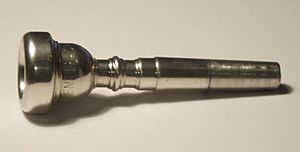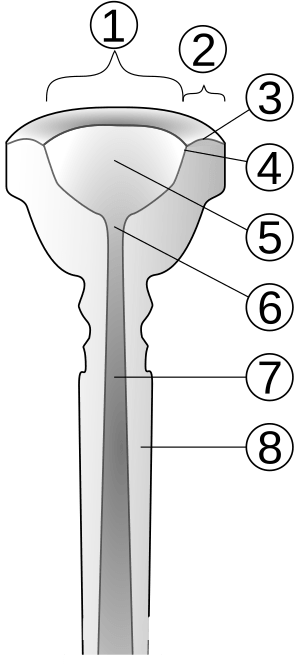Mouthpiece (brass) facts for kids

A brass mouthpiece is the part of a brass instrument that a player blows into to make a sound. The purpose of a mouthpiece is to send vibrations down the instrument to make a musical note.
Larger mouthpieces are used on larger instruments, and smaller ones are used on smaller instruments. This is because a larger mouthpiece makes a lower sound, and a smaller mouthpiece makes a higher sound, and bigger instruments make lower sounds and smaller instruments make higher sounds.
Contents
Different parts of a brass mouthpiece

Part 1: Inner rim
Part 2: Rim
Part 3: The contour, or shape, of the rim
Part 4: Rim edge
Part 5: Cup
Part 6: Throat
Part 7: Backbore
Part 8: Shank
A mouthpiece has many different parts, and all its parts have different names.
- Rim - The rim of a trumpet mouthpiece is the part that makes a circle at the top of the mouthpiece, and is the part that is in physical contact with you when playing.
- Cup - The cup of a mouthpiece is the part inbetween the rim and the back bore. This is where the air coming from the players mouth enters the mouthpiece and due to the concave shape forces the air into the backbore.
- Throat, backbore, and shank - The backbore is where the air escapes through into the throat and shank, the shank is the long piece of hollow metal coming from the cup of the mouthpiece, it should be the only part of the mouthpiece in contact with the instrument.
Different ways to make a brass mouthpiece
Some very small changes in how a mouthpiece is made can change the sound of an instrument a lot.
| Part of mouthpiece | How it can change the instrument's sound |
|---|---|
| Inner rim diameter | Larger inner rim diameters, or the inside part of rims that are wider, are good for playing low notes and improve tonal quality, and smaller diameters help a player play notes that are higher, with a sacrifice of the lower range and tone. |
| Rim width | Wider rim widths, or rims that are wider, are good for letting a player play for a longer time, but they do not let a player play as many notes. |
| Rim contour | Flatter "rim contours", or the shape of the top of the rim, are usually on trumpets with sharper "rim edges" (see below) |
| Rim edge (also called bite) | Sharper rim edges, or rim edges that are less curvy, do not let a player play for a long time, but they let them make a better sound. |
| Cup depth | Shallower cups, or cups that are not as thick, help out a player to play very high notes, but the notes that they play do not sound as good. Deeper cups, or thinker, wider cups, make a very good sound, but do not allow a player to play very high notes. |
| Cup shape | Semi-spherical cups, or cups shaped like a half-circle, make notes that are easy to tell apart, and conical cups, or cups shaped like cones, play notes that are harder to tell apart. |
| Throat diameter | Larger throat diameters, or wider throats, help a player to play louder, but they do not make the instrument sound as good. Smaller throat diameters sound very good, but do not let a player play as loud. |
| Backbore | More conical backbores, or backbores that are shaped like cones, sound more "full", but more cylindrical ones, or backbores that are shaped like cylinders, give a sound that is clear and "choppy". |
Substances that mouthpieces for brass instruments can be made out of
Gold plating
Some players gold plate their brass mouthpieces, or cover them with a thin layer of gold. This makes the sound of the instrument better than with any other mouthpiece. For some people that are allergic to silver, this is the best (but not cheapest) way to play a brass instrument without getting sick. Gold does not smudge, so it only has to be cleaned with soap and water once in a while.
Silver plating

Silver plating is almost always used on brass mouthpieces because it does not cost too much money and a silver-plated mouthpiece helps a player make a pretty good sound. Silver plating is not as expensive as gold, but it is sometimes very important to have if a player plays a certain way. Silver-plate gives a clearer sound than gold and is good for styles of playing that need a lot of volume. Also, silver needs to be cleaned more often because it smudges easily.
Plastic
Another type of mouthpiece is a plastic mouthpiece. These mouthpieces are good because they never break or dent, they do not cost as much as silver or gold mouthpieces, and they are good for playing outdoors. They are very often given to players in marching bands. They do not make as good sounds as silver or gold mouthpieces, though.
Steel and titanium
Two of the newest things mouthpieces can be made out of are stainless steel and titanium. They are very rare, and are only made by a few companies. Steel and titanium mouthpieces do not vibrate as much, so they make a very clear sound, require much less cleaning, and they do not need to be silver plated. However, they are much more expensive than mouthpieces that are silver or gold plated.
Other pages
Images for kids
See also
 In Spanish: Boquilla (viento-metal) para niños
In Spanish: Boquilla (viento-metal) para niños


